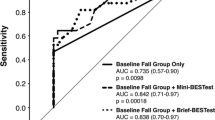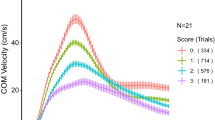Abstract
We compared the sensitivity and consistency of a new Push and Release Test versus the Pull Test (item 30 of the Unified Parkinson’s Disease Rating Scale; UPDRS) as clinical measures of postural stability. Subjects with Parkinson’s disease and age-matched control subjects participated in 3 protocols investigating: (1) the sensitivity and specificity of the two tests related to the subjects’ balance confidence, as measured by the Activities-specific Balance Confidence (ABC) scale, (2) the inter-rater reliability of the two tests, and (3) the consistency of the perturbation forces applied to the subjects by each balance test. As a test for concurrent validity, the balance tests were also compared with the subjects’ retrospective reports of fall frequency. Compared with the Pull Test, the Push and Release Test was more sensitive to subjects with low balance confidence, but less specific for subjects with high balance confidence. The inter-rater correlations were higher with the Push and Release Test. Examiners applied more consistent perturbation forces to the subjects with the Push and Release Test than with the Pull Test. The Push and Release Test correlated better with self-reported falls. Therefore, the Push and Release Test provided a more sensitive and consistent test of postural stability than the Pull Test.




Similar content being viewed by others
References
Adkin AL, Frank JS, Jog MS (2003) Fear of falling and postural control in Parkinson’s disease. Mov Disord 18:496–502
Bloem BR, Grimbergen YA, Cramer M, Willemsen M, Zwinderman AH (2001) Prospective assessment of falls in Parkinson’s disease. J Neurol 248:950–958
Cummings SR, Nevitt MC, Kidd S (1988) Forgetting falls. The limited accuracy of recall of falls in the elderly. J Am Geriatr Soc 36:613–616
Duncan PW, Weiner DK, Chandler J, Studenski S (1990) Functional reach: a new clinical measure of balance. J Gerontol 45:M192–197
Fahn S, Elton R (1987) Unified Parkinson’s disease rating scale. In: Fahn S, Marsden D, Calne D (eds) Recent Developments in Parkinson Diseases. Macmillan, London, pp 153–163
Fregly AR, Graybiel A (1968) An ataxia test battery not requiring rails. Aerosp Med 39:277–282
Friedman SM, Munoz B, West SK, Rubin GS, Fried LP (2002) Falls and fear of falling: which comes first? A longitudinal prediction model suggests strategies for primary and secondary prevention. J Am Geriatr Soc 50:1329–1335
Horak FB, Jacobs JV, Tran VK, Nutt JG (2004) The push and release test: An improved clinical postural stability test for patients with Parkinson’s disease. Mov Disord 19:S170
Lajoie Y, Gallagher SP (2004) Predicting falls within the elderly community: comparison of postural sway, reaction time, the Berg balance scale and the Activities-specific Balance Confidence (ABC) scale for comparing fallers and non-fallers. Arch Gerontol Geriatr 38:11–26
Munhoz RP, Li JY, Kurtinecz M, Piboolnurak P, Constantino A, Fahn S, Lang AE (2004) Evaluation of the pull test technique in assessing postural instability in Parkinson’s disease. Neurology 62:125–127
Myers AM, Powell LE, Maki BE, Holliday PJ, Brawley LR, Sherk W (1996) Psychological indicators of balance confidence: relationship to actual and perceived abilities. J Gerontol A Biol Sci Med Sci 51:M37–M43
Nutt JG, Hammerstadt JP, Gancher ST (1992) Parkinson’s disease: 100 maxims. Edward Arnold, London
Powell LE, Myers AM. The Activities-specific Balance Confidence (ABC) Scale (1995) J Gerontol A Biol Sci Med Sci 50A:M28–M34
Visser M, Marinus J, Bloem BR, Kisjes H, van den Berg BM, van Hilten JJ (2003) Clinical tests for the evaluation of postural instability in patients with Parkinson’s disease. Arch Phys Med Rehabil 84:1669–1674
Acknowledgement
The authors thank Maryann Seeger PT and Kevi Ames PT for serving as raters, Kate Doebke RN and the OHSU Movement Disorders clinicians for referring subjects, and Linda Kleen RN and the YMCA for referring subjects. The authors also thank Patricia Carlson-Kuhta PhD, Leta Guptill, and Triana Nagel-Nelson for help with data collection, Andrew Owings for assembling and testing the pressure-sensitive gloves, and Dawn Peters for statistical assistance. The authors extend deep gratitude to our subjects for their participation. This project was supported by NIH grant AG-06457.
Author information
Authors and Affiliations
Corresponding author
Additional information
Received in revised form: 2 March 2006
Rights and permissions
About this article
Cite this article
Jacobs, J.V., Horak, F.B., Van Tran, K. et al. An alternative clinical postural stability test for patients with Parkinson’s disease. J Neurol 253, 1404–1413 (2006). https://doi.org/10.1007/s00415-006-0224-x
Received:
Accepted:
Published:
Issue Date:
DOI: https://doi.org/10.1007/s00415-006-0224-x




